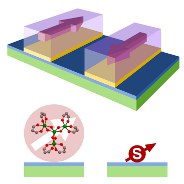Molecular Magnetism & Spintronics
Nanomagents with intrinsic magnetic properties show a rich interplay with transport proceses when they are embedded in an electronic circuit, especially when the latter contains ferromagnets.
Spin-valves with Molecular Magnets/Adatoms
Single-molecule magnets (SMMs) or magnetic atoms exhibiting a large spin and magnetic anisotropy – key properties responsible for magnetic bistability – are prospective candidates for applications in information storage and processing technologies.
Especially attractive is the idea of incorporating an SMM or magnetic atom into a spintronic device, e.g. as an element of a spin-valve. It should allow for using a spin-polarized current to control the magnetic state of the molecule/atom, and in particular for switching its spin between the two axial spin states “up” and “down”.
This current-induced magnetic switching can be view as a mechanism of writing a bit of information into a SMM-/atom-based memory cell. On the other hand, the measurement of the spin-valve’s conductance, which depends on the relative orientation of the SMM’s/atom’s spin and the magnetic moments of electrode(s), can serve as the readout mechanism.
M. Misiorny and J. Barnas, Phys. Rev. Let. 111, 046603 (2013)

(M. Misiorny)
Transport Spectroscopy of Molecular Magnets
Though addressing the transport properties of a single molecule poses a serious challenge, transport spectroscopy is an invaluable tool in studying molecular magnets. By placing an individual molecule in a three-terminal junction, not only does one gain access to different charge states, but also by proper electrical gating one gets some control over the molecule’s magnetic properties. Furthermore, by measuring how the position of the charge degeneracy point depends on an external magnetic field, the magnetic anisotropy of the molecule can determined. Interestingly enough, when the relative orientation of the system and the field is changed the linear transport shows signatures originating from the magnetic anisotropy.
A. S. Zyazin, et. al, Nano Lett. 10, 3307 (2010)
(M. Misiorny, M. R. Wegewijs)

